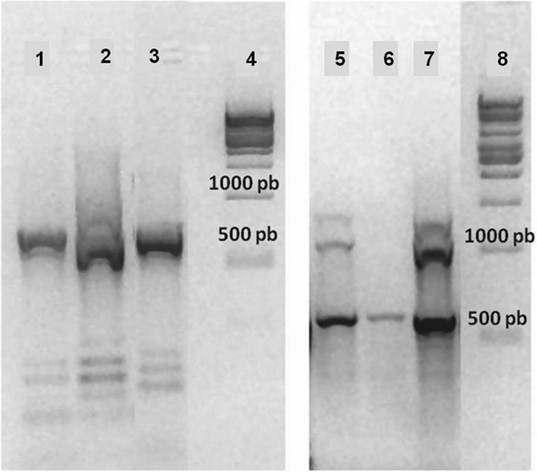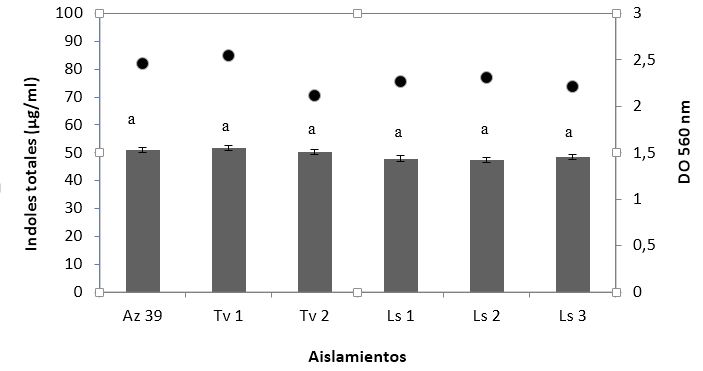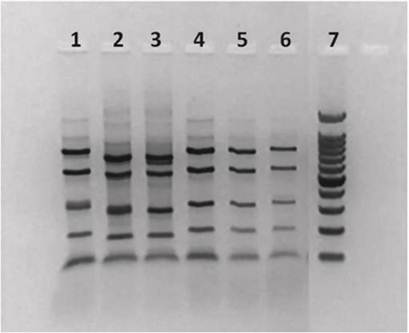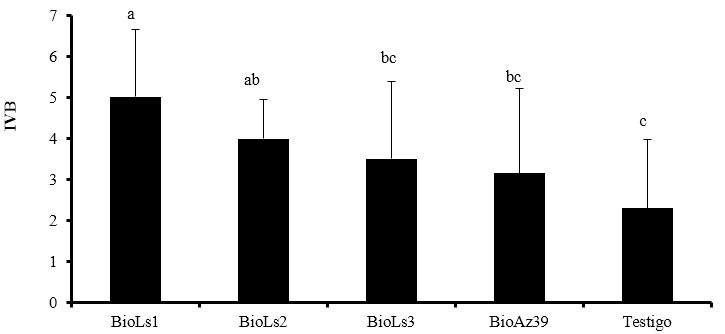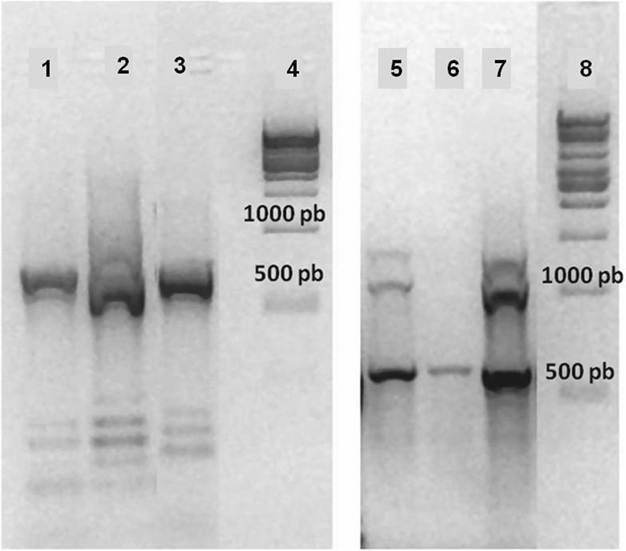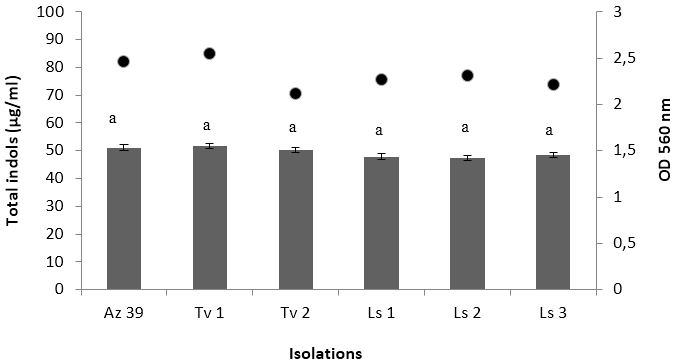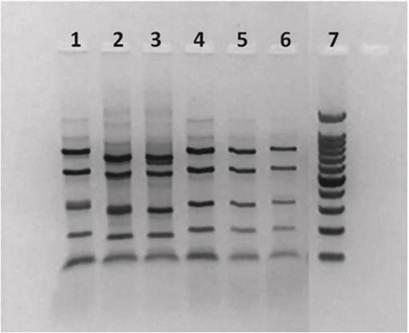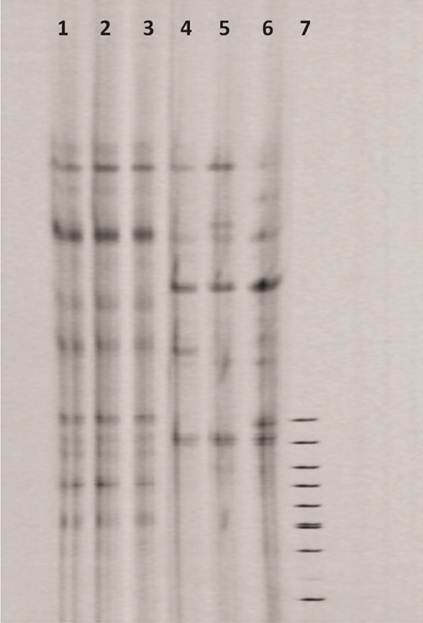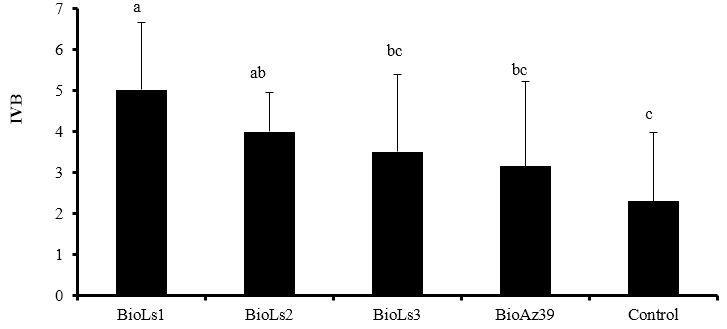Translate PaperArtículo originalAislamiento, caracterización y actividad de cepas de Azospirillum brasilense asociadas a la caña de azúcar
Dra.C. María Laura Tortora [1] [*]
Lic. Noel Grellet-Naval [2]
María de los Ángeles Núñez [1]
Dr.C. Eduardo Raúl Romero [1]
[1] Subprograma
Agronomía, Sección Caña de Azúcar, Estación Experimental Agroindustrial
Obispo Colombres (EEAOC), Av. William Cross Nº3150, Las Talitas,
Tucumán, Argentina
[2] Ledesma
S.A.A.I, Libertador General San Martin, Jujuy, Argentina.Dirección
postal: Av. William Cross Nº 3150, Las Talitas, Tucumán, Argentina
[*] Autor para correspondencia. ltortora@eeaoc.org.ar
RESUMENEn Argentina, la
caña de azúcar es uno de los cultivos bioenergéticos de mayor potencial.
Por su gran capacidad de producción de biomasa, el cultivo posee altos
requerimientos de nitrógeno que pueden suplirse mediante fertilización
química. Para asegurar la sostenibilidad de los programas bioenergéticos
y reducir los problemas ambientales generados por los fertilizantes
sintéticos, es necesario reemplazarlos en un corto plazo. En este
sentido, la inoculación con Azospirillum constituye la
alternativa más utilizada en esta región para incrementar los
rendimientos de los cañaverales. El objetivo de este trabajo fue aislar y
caracterizar bacterias del género Azospirillum a partir de la
caña de azúcar, analizar algunas de sus características como bacteria
promotora del crecimiento vegetal (PGPB) y evaluar el efecto de
bioproductos formulados con los aislados obtenidos, sobre el rebrote del
cultivo. Se obtuvieron tres aislados endofíticos (Ls1, Ls2 y Ls3) y dos
rizosféricos (Tv1 y Tv2), con capacidad potencial para fijar nitrógeno
atmosférico y producir indoles totales. Según restricción y
secuenciación del gen 16S, los aislados se identificaron como A. brasilense.
La genotipificación por BOX-PCR, confirmó que Ls1, Ls2 y Ls3 son
distintas entre sí y a la cepa Az39, a diferencia de lo observado para
Tv1 y Tv2, que se corresponden con esta cepa de referencia. Mediante
bioensayos en invernáculo, se observó que la inoculación del
biopreparado obtenido con Ls1 incrementó, significativamente, el índice
de velocidad de brotación de la caña de azúcar, por lo que podría
considerarse como un potencial biofertilizante en este cultivo.
INTRODUCCIÓNAzospirillum es considerada como una de las bacterias promotoras del crecimiento vegetal (PGPB, por sus siglas en inglés de Plant Growth Promoting Bacteria) más importantes 1.
La capacidad de esta bacteria de promover el crecimiento e incrementar
la producción de diversas especies vegetales, se debe a la existencia de
mecanismos de acción como la producción de fitohormonas, la fijación
biológica de nitrógeno (FBN) y la capacidad para limitar el crecimiento
de ciertos organismos fitopatógenos, como la antibiosis y la producción
de sideróforos 2. Azospirillum es
capaz de asociarse con 113 especies de plantas, 14 de las cuales son
gramíneas y las restantes corresponden a otras 34 familias botánicas 3. En este sentido, existen numerosos trabajos que confirman la capacidad de Azospirillum para asociarse, tanto en forma endofítica como rizosférica, al cultivo de la caña de azúcar 4.
En
Argentina, la producción de caña de azúcar es una de las actividades
agroindustriales más importantes. Por sus condiciones climáticas y
edáficas, Tucumán es la provincia que presenta mayor producción de caña
de azúcar, con una superficie cosechable de 269 530 ha para la zafra
2017 5. La caña de azúcar, es considerada
uno de los cultivos bioenergéticos de mayor potencial, ya que permite
obtener no sólo azúcar como alimento, sino también bioetanol a partir de
su fermentación y cogenerar energía eléctrica a partir de la
utilización de sus residuos de cosecha. El cultivo posee elevados
requerimientos de nitrógeno (entre 180 y 250 kg ha-1 por año-1),
debido a su gran capacidad de producción de biomasa, asociada a la
prolongada duración de su ciclo, parte de este nutriente asimilado por
la planta es aportado por la mineralización de la materia orgánica del
suelo; sin embargo, no resulta suficiente para satisfacer los
requerimientos del cultivo, por lo que la fertilización nitrogenada
constituye una práctica agronómica necesaria.
Actualmente,
la urea es el fertilizante nitrogenado más utilizado y se aplican
aproximadamente 240 kg de urea por ha por año. Sin embargo, sólo entre
el 20 y el 50 % del nitrógeno aplicado es utilizado por el cultivo, el
resto no asimilado se pierde por lixiviación, denitrificación o
volatilización, convirtiendo al fertilizante químico en una fuente
importante de contaminación ambiental. Por otro lado, la síntesis de
estos fertilizantes demanda altos niveles de energía fósil, por lo que a
fin de lograr la sostenibilidad de los programas bioenergéticos, es
necesario reemplazarlos totalmente en un corto plazo.
Diferentes
estudios han demostrado que la caña de azúcar es capaz de obtener hasta
un 70 % de sus requerimientos de nitrógeno a partir de la FBN 6,
proceso llevado a cabo por diferentes bacterias, rizosféricas y
endofíticas, capaces de asociarse y colonizar a la caña de azúcar, entre
las que se encuentran las del género Azospirillum. La asociación Azospirillum-caña de azúcar, constituye el punto de partida de los programas de FBN con plantas no leguminosas a nivel mundial 6.
Estos antecedentes, junto con el creciente interés por implementar
sistemas agronómicos sustentables en el manejo de los cañaverales
mediante la utilización de bacterias PGP, ha llevado a que en la
actualidad, cerca de 10000 ha de cañaverales de Tucumán, se inoculen con
bioproductos comerciales que contienen a la cepa A. brasilense
Az39 en su composición (resultados no publicados). Esta inoculación
permite incrementar la brotación y emergencia de las plántulas, logrando
el rápido establecimiento del cañaveral.
Teniendo en cuenta estas consideraciones, el objetivo de este trabajo fue aislar y caracterizar bacterias del género Azospirillum,
a partir de caña de azúcar; analizar algunas de sus características
promotoras del crecimiento y evaluar el efecto sobre la brotación del
cultivo.
MATERIALES Y MÉTODOSAislamiento de bacterias del género Azospirillum
Se tomaron muestras de suelo rizosférico y
raíces de plantas de caña de azúcar de la variedad LCP 85-384,
pertenecientes a cañaverales ubicados en “Los Gómez” y “Las Talitas”,
departamento Leales y Tafí Viejo, respectivamente.
Las bacterias del género Azospirillum se aislaron siguiendo la técnica descrita por Döbereiner et al. 7.
Para el aislamiento de bacterias rizosféricas, de cada localidad se
tomaron tres muestras de suelo rizosférico de 0-15 cm de profundidad.
Cada muestra evaluada; a su vez, estaba constituida por cinco
submuestras de aproximadamente 500 g cada una. A partir de estas
muestras, se realizaron diluciones sucesivas en solución fisiológica
estéril (NaCl 0,9 % m v-1) y alícuotas de 100 μL se sembraron en el medio de cultivo semisólido malato libre de nitrógeno (NFb) (ácido málico 5 g L-1; K2HPO4 0,5 g L-1; MgSO4.7H2O 0,2 g L-1; NaCl 0,1 g L-1; CaCl2.2H2O 0,02 g L-1; KOH 4,5 g L-1; agar 1,75 g L-1;
pH 6,8 ajustado con KOH). Para el aislamiento de bacterias endofíticas,
de cada localidad se tomaron muestras de raíces de cinco plantas
independientes, distanciadas por 3 m aproximadamente y escogidas al
azar. De cada planta se tomaron cuidadosamente 10 raíces de 5 a 15 cm,
que se desinfectaron de manera superficial con etanol 70 %, 1 min,
hipoclorito de sodio al 2 % (v v-1) y cinco lavados con agua
destilada estéril. Las raíces desinfectadas se cortaron en fragmentos de
1 cm y se transfirieron al medio de cultivo NFb semisólido. Los frascos
se incubaron durante cinco días a 30 °C. Los cultivos que presentaron
crecimiento bacteriano en forma de una película blanca sub superficial,
típica de Azospirillum, se repicaron en el medio de cultivo NFb sólido adicionado con extracto de levadura (5 g L-1) y Rojo Congo (15 mL L-1 de una solución acuosa 1:400 (p v-1), para la identificación de colonias pequeñas, secas, color rojo escarlata 8.
Análisis de las características promotoras del crecimientoLa
fijación biológica de nitrógeno se analizó según la capacidad de los
aislados de crecer en el medio de cultivo NFb libre de nitrógeno y por
amplificación mediante PCR de un fragmento de 710 pb del gen nifD de la nitrogenasa, enzima involucrada en el proceso de fijación de nitrógeno. Como cebadores se utilizaron nifDf y nifDr (Sigma-Aldrich, EE.UU) 9.
La capacidad de los aislados para producir indoles, se evaluó siguiendo
la técnica colorimétrica descrita por Glickmann y Dessaux 10.
Para ello, una colonia aislada en el medio NFb sólido se sembró en el
medio de cultivo líquido Luria Bertani (LB) (extracto de levadura 5 g L-1; tripteína 10 g L-1; NaCl 10 g L-1).
Los cultivos se incubaron a 30 °C con agitación (45 r.p.m). A las 24,
48, 72 y 96 h se tomaron muestras para evaluar el crecimiento bacteriano
por determinación de la densidad óptica a 560 nm (DO560nm).
La concentración de índoles totales producidos y excretados al medio de
cultivo se determinó a las 96 h de incubación, midiendo la DO530nm
y extrapolando los valores obtenidos en una curva de calibración en la
que se utilizó ácido indol acético puro (AIA) como estándar. Como
referencia se utilizó la cepa Az39 de A. brasilense.
Todos
los ensayos correspondientes a la determinación de las características
promotoras del crecimiento se realizaron por triplicado para cada cepa
evaluada. Los datos se analizaron estadísticamente mediante análisis de
la varianza (ANOVA) y la Prueba de LSD Fisher, con el programa InfoStat
(Software Estadístico, 2010) para Windows.
Caracterización molecular de los aisladosAmplificación por PCR, secuenciación y ARDRA del gen 16S ADNrA fin de confirmar que los aislados obtenidos pertenecen al género Azospirillum, se realizó su caracterización molecular mediante amplificación por PCR de un fragmento de 1450 pb del gen 16S ADNr, utilizando los cebadores 27f y 1492r (Biodynamics, Argentina). Los productos amplificados, por un lado, se enviaron al Centro de Referencia para Lactobacillus (CERELA) para su secuenciación y se analizaron utilizando el programa BLAST (Basic Local Alignment Search Tool). Por otro lado, se realizó la digestión de los productos amplificados siguiendo la técnica ARDRA (Amplified Ribosomal DNA Restriction Analysis) con la enzima de restricción AluI (Thermo Scientific, EE.UU). Los fragmentos obtenidos se colocaron en un gel de agarosa al 1,5 % (p v-1) a fin de comparar los perfiles de restricción.
Genotipificación por BOX-PCRFinalmente, para identificar los distintos aislados a nivel de cepa, se utilizó la técnica BOX-PCR utilizando el cebador boxa1r (Sigma Aldrich, EE.UU) 11.
Esta técnica se basa en la amplificación por PCR de secuencias de ADN
intergénicas, utilizando un cebador que hibrida de forma específica con
secuencias repetitivas (secuencias rep) del genoma bacteriano 12.
Los perfiles de bandas generados son únicos entre especies, incluso
entre cepas. Las condiciones para llevar a cabo la amplificación fueron:
desnaturalización a 95 °C 2 min, seguido por 35 ciclos de 94 °C 3 s, 92
°C 30 s, 50 °C 1 min, 65 °C 2 min, con una extensión final a 65 °C por 8
min. Los productos amplificados fueron separados por electroforesis en
gel de poliacrilamida, con acople a Li-Cor (Biosciences, EE.UU) para su
detección. Para realizar la caracterización molecular de los nuevos
aislados, se utilizó como referencia la cepa Az39 de A. brasilense.
Selección de los aislados y formulación de biofertilizantesLos aislados de Azospirillum
que mostraron diferencias en su huella genética luego de realizar la
BOX-PCR, se seleccionaron y enviaron a una empresa productora de
biofertilizantes para la formulación de diferentes bioproductos.
Bioensayo sobre caña de azúcarSe
evaluó el efecto de cuatro bioproductos (Bio) formulados a partir de
los aislados Ls1, 2 y 3 y de la cepa de referencia Az39 (BioLs1, BioLs2,
BioLs3 y BioAz39, respectivamente) sobre la velocidad de brotación del
cultivo de la caña de azúcar. Para ello, estacas uninodales extraídas a
partir del tercio medio de tallos de caña semilla de la variedad LCP
85-384, se inocularon por riego con 5 mL de cada biofertilizante.
Considerando que la concentración óptima para la inoculación con biofertilizantes a base de Azospirillum corresponde a 1 x 106 ufc mL
-1 (13)
y que los bioproductos tenían una concentración promedio de 1 x 109 ufc mL-1 se realizaron las diluciones correspondientes (1:1000 v v-1)
de cada bioproducto antes de su aplicación. Por cada tratamiento
evaluado, se sembraron 12 estacas uninodales en bandejas de plástico
utilizando arena fina estéril como sustrato. Luego de la inoculación,
las bandejas se conservaron en invernáculo a 25 °C. Las bandejas se
colocaron en un diseño experimental de bloques completamente
aleatorizados. Se trabajó con tres repeticiones por tratamiento y como
control positivo se utilizó el biofertilizante a base de la cepa Az39 de
A. brasilense (BioAz39).
Los resultados se expresaron como índice de velocidad de brotación (IVB) 14, calculados a partir de la siguiente fórmula:

donde B es el número de brotes y N los días después de la plantación.
Los
datos se analizaron estadísticamente mediante el análisis de la
varianza (ANOVA) y la Prueba de LSD Fisher, con el programa InfoStat
(Software Estadístico, 2010) para Windows.
RESULTADOS Y DISCUSIÓNAislamiento y caracterizaciónSe obtuvieron tres aislados endofíticos con características típicas del género Azospirillum
a partir de raíces de caña de azúcar del departamento “Leales”, que se
denominaron Ls1, Ls2 y Ls3 y dos rizosféricos del departamento Tafí
Viejo, los cuales se denominaron Tv1 y Tv2. La asociación de Azospirillum
con las raíces de la caña de azúcar sólo puede ser exitosa si la
bacteria es capaz de sobrevivir en el suelo y alcanzar poblaciones
significativas en el sistema radicular, por lo que estos resultados
confirman la capacidad que tiene este género bacteriano de colonizar
naturalmente el cultivo de la caña de la azúcar 15.
Si bien las bacterias del género Azospirillum
son generalmente consideradas como bacterias de la rizósfera, algunas
cepas desarrollan diferencias específicas en la forma de colonizar las
raíces. Predominantemente colonizan la superficie de la raíz y sólo unas
pocas cepas son capaces de colonizar el interior de las raíces. Estas
cepas endofíticas, al encontrarse en un ambiente protegido de las
condiciones ambientales, tienen mecanismos específicos para comunicarse e
interactuar con la planta de manera mucho más eficiente que las cepas
rizosféricas.
Fijación biológica de nitrógeno (FBN)Todos los aislados fueron capaces de crecer en medio NFb, formando una película blanca subsuperficial 7. Además, la presencia del gen nifD de la nitrogenasa proporciona evidencia de la capacidad potencial de dichos aislados de fijar nitrógeno atmosférico (Figura 1), en concordancia con lo informado por otros autores 9.
Amplificación por PCR del gen nifD (710 pb) de los aislados obtenidos
La
amplificación corresponde a las cepas rizosféricas de Tafí del Valle
Tv1 y Tv2 (líneas 1 y 2), cepa Az39 usada como referencia (línea 3),
marcador de peso molecular 1Kb (Promega, EE.UU) (líneas 4 y 8), cepas
endofíticas de Leales Ls1, Ls2 y Ls3 (líneas 5, 6 y 7)
Actualmente, la contribución de Azospirillum
a los requerimientos de nitrógeno de la caña de azúcar por medio de la
FBN, es un tema controversial. Algunos reportes de investigación afirman
que el cultivo es capaz de obtener hasta un 70 % de sus requerimientos
de nitrógeno a partir de la FBN y que éste constituye el principal
mecanismo de promoción del crecimiento de las bacterias de este género 16, otros suponen que Azospirillum
utiliza el nitrógeno de la FBN para su propio uso y la contribución de
nitrógeno al cultivo está relacionada con la asimilación de nitratos 17.
Producción de indoles totalesEn la Figura 2 se muestra la producción de indoles totales expresada en µg mL-1 en función del crecimiento bacteriano, evaluado por medición de la densidad óptica a 560 nm.
Crecimiento (DO560) (círculos) y producción de indoles totales (µg mL-1l) (barras) de los distintos aislados a las 96 hs de incubación a 30 ºC
Letras iguales indican sin diferencias estadísticamente significativas (LSD, p ≤ 0,05)
Como se puede observar en la Figura 2, todos los aislados sintetizaron y excretaron al medio indoles totales, en cantidades similares a la cepa Az39 de A. brasilense. La producción de fitohormonas, es una de las características PGPB más importante del género Azospirillum18.
Estas bacterias producen y liberan al medio de cultivo diferentes
fitohormonas, durante la fase estacionaria de crecimiento, entre las
cuales se han encontrado auxinas, giberelinas, ácido abscísico, etileno y
ácido salicílico. Si bien estas fitohormonas afectan significativamente
el crecimiento de la raíz, resultando en una mejor absorción de humedad
y nutrientes, también se ha demostrado que participan en el incremento
del crecimiento de los cultivos cuando Azospirillum se aplica de manera foliar 2.
Por esta razón, la producción de fitohormonas es importante, no sólo
para la producción de inoculantes a nivel industrial, sino también para
la acción de estas bacterias en la filósfera, en la rizósfera e incluso
dentro de las plantas. Se ha observado que la inoculación con Azospirillum
y con las fitohormonas producidas por estas rizobacterias, inducen una
mayor respuesta de promoción de crecimiento en semillas y plántulas 2.
Los resultados obtenidos con los nuevos aislados, productores de
indoles, son importantes para la selección y posterior formulación de
posibles biofertilizantes 19.
Caracterización molecularAmplificación por PCR, secuenciación y ARDRA del gen 16S ADNrEn la Figura 3 se muestra la amplificación por PCR del gen 16S del ADNr de los diferentes aislados obtenidos y su posterior digestión con la enzima de restricción AluI. Los perfiles obtenidos se compararon con los de la cepa Az39 de A. brasilense utilizada como referencia.
Perfil de electroforesis de los fragmentos obtenidos luego de la restricción del ADNr 16S con la enzima de restricción AluI
Los
patrones corresponden a la cepa Az39 usada como referencia (línea 1),
cepas rizosféricas de Tafi del Valle Tv1 y Tv2 (líneas 2 y 3), cepas
endofíticas de Leales Ls1, Ls2 y Ls3 (líneas 4, 5 y 6), marcador de peso
molecular de 100 pb (Promega, EE.UU) (línea 7)
Se observó que los aislados presentaron el mismo perfil de restricción que la cepa de referencia Az39 de A. brasilense, por lo que se infiere que los mismos podrían corresponder a dicha especie del género Azospirillum. La secuenciación del gen 16S del ADNr y su posterior análisis utilizando el programa BLAST, permitió confirmarlo (Tabla 1).
Genotipificación por BOX-PCRLos patrones de polimorfismo generados por BOX-PCR se han utilizado para la diferenciación de cepas bacterianas del género Azospirillum20. En la Figura 4 se muestran las diferentes huellas genéticas de los aislados, obtenidas por BOX-PCR.
Huella genética de los diferentes aislados obtenida por BOX-PCR
Los
patrones corresponden a las cepas rizosféricas de Tafí del Valle Tv1 y
Tv2 (líneas 1 y 2), cepa Az39 usada como referencia (línea 3), cepas
endofíticas de Leales Ls1, Ls2 y Ls3 (líneas 4, 5 y 6, respectivamente) y
línea 7, marcador de peso molecular de 1Kb (Promega, EE.UU)
La técnica BOX-PCR mostró que los aislados Tv1 y Tv2 tienen el mismo perfil de bandas que Az39 de A. brasilense,
por lo que podemos confirmar que se trata de la misma cepa. Por el
contrario, los perfiles de Ls1, Ls2 y Ls3 son distintos entre sí y con
el perfil de la cepa Az39, por lo que se puede confirmar que son cepas
diferentes.
Bioensayo sobre caña de azúcarLos
aislados Ls1, Ls2 y Ls3 fueron seleccionados por ser endófitos y por
presentar diferencias en su huella genética respecto a la cepa Az39,
para la formulación de bioproductos que se denominaron BioLs1, BioLs2 y
BioLs3. Además se utilizó a BioAz39 como control positivo de inducción
de crecimiento. El índice de velocidad de brotación (IVB) de las estacas
de caña de azúcar inoculadas con los diferentes biofertilizantes, se
muestra en la Figura 5.
Índice
de velocidad de brotación (IVB) de las estacas uninodales de caña de
azúcar inoculadas con los biofertilizantes formulados a partir de los
aislados seleccionados
Los
valores de IVB corresponden al promedio de tres determinaciones y las
barras de error indican desvío estándar (DE). Diferentes letras indican
diferencias significativas (LSD, p≤0,05)
Entre los bioproductos evaluados, BioLs1 fue
el que presentó mayor capacidad para incrementar la brotación de
estacas uninodales de caña de azúcar, luego de su aplicación (Figura 5).
BioLs1 presentó diferencias estadísticamente significativas en
comparación con BioLs3, BioAz39 y con el testigo sin inocular. Por otro
lado, los bioproductos BioLs1 y BioLs2 incrementaron de manera
significativa el IVB en comparación con el testigo sin inocular. El IVB
fue de 2,30 para el testigo, mientras que para BioLs1 y BioLs2 fue de
5,02 y 4,01 respectivamente. Es importante destacar que el bioproducto
BioLs1, formulado a partir del aislado residente A. brasilense Ls1, presentó mayor capacidad de incrementar el IVB de la caña de azúcar que BioAz39, el cual contiene A. brasilense
Az39, la cepa más utilizada en nuestra región para la formulación de
inoculantes para caña de azúcar. La importancia de la FBN durante el
crecimiento inicial de la caña de azúcar, se debe a que el ritmo de
absorción de N que tiene el cultivo, es máximo en los primeros meses
desde la brotación. En este período el cultivo absorbe más N del que
utiliza para su crecimiento y desarrollo, almacenando el exceso como
sustancias orgánicas en sus tejidos (vainas y láminas foliares). Luego,
ese N es removilizado hacia zonas de activo crecimiento para satisfacer,
junto con el N aportado desde el suelo, los elevados requerimientos de
la fase de gran crecimiento. Este comportamiento representa una
estrategia de administración biológica de N, que le garantiza no
comprometer el crecimiento 21. Por esta
razón, la utilización de bioproductos a base de bacterias PGP capaces de
llevar a cabo la FBN y de producir y excretar fitohormonas permitiendo
el rápido establecimiento de la planta en sus estadíos iniciales de
crecimiento y desarrollo, resulta de fundamental importancia teniendo en
cuenta que emergencias pobres y prolongadas afectan el cumplimiento
efectivo de las siguientes fases fenológicas del cultivo, disminuyendo
significativamente la producción y el rendimiento del cañaveral
(21)
.
CONCLUSIONES
Se logran aislar y caracterizar diferentes cepas de A. brasilense
asociadas al cultivo de la caña de azúcar, con capacidad potencial para
fijar nitrógeno atmosférico y sintetizar indoles. Los perfiles de
bandas obtenidos por BOX-PCR permiten confirmar que las cepas Ls1, Ls2 y
Ls3 son cepas diferentes entre sí y a la cepa Az39. Los bioproductos
BioLs1 y BioLs2 muestran un efecto positivo sobre el IVB de la caña de
azúcar, en comparación con el testigo sin inocular, en bioensayos
realizados bajo condiciones controladas. El bioproducto BioLs1 provoca
además un incremento en la velocidad de brotación de las plántulas
inoculadas, en comparación con BioAz39.
En este sentido, los aislados A. brasilense
Ls1 y Ls2 con capacidad potencial para fijar nitrógeno y producir
indoles, constituyen cepas promisorias asociadas a la caña de azúcar que
podrían ser utilizadas para la formulación de biofertilizantes, a fin
de incrementar los rendimientos y la producción del cultivo.
Traducir DocumentoOriginal ArticleIsolation, characterization and activity of Azospirillum brasilense strains associated to sugarcane
Dra.C. María Laura Tortora [1] [*]
Lic. Noel Grellet-Naval [2]
María de los Ángeles Núñez [1]
Dr.C. Eduardo Raúl Romero [1]
[1] Subprograma
Agronomía, Sección Caña de Azúcar, Estación Experimental Agroindustrial
Obispo Colombres (EEAOC), Av. William Cross Nº3150, Las Talitas,
Tucumán, Argentina
[2] Ledesma
S.A.A.I, Libertador General San Martin, Jujuy, Argentina.Dirección
postal: Av. William Cross Nº 3150, Las Talitas, Tucumán, Argentina
[*] Autor para correspondencia. ltortora@eeaoc.org.ar
ABSTRACTSugarcane is one of
the most relevant bioenergy crops in Argentina. Due to its high capacity
for biomass production, the crop has a high nitrogen requirement that
can be supplied using chemical fertilizers. To ensure the sustainability
of bioenergy programs and reduce the environmental issues caused by
synthetic fertilizers, it is necessary to replace them in a short term.
In this sense, Azospirillum inoculation constitutes the most used
alternatives in our region to increase sugarcane plantations yields.
The objective of this work was to isolate and characterize Azospirillum
bacteria from sugarcane, analyze some of their PGPB characteristics and
evaluate the effect of bioproducts formulated with the obtained
isolates on crop sprouting. Three endophytic isolates (Ls1, Ls2 and Ls3)
and two from the rhizosphere (Tv1 and Tv2) were obtained, with
potential ability to fix atmospheric nitrogen and produce total indoles.
Using 16S gene restriction and sequencing, the isolates were identified
as A. brasilense. Genotyping by BOX-PCR, confirmed that Ls1, Ls2
and Ls3 were different from each other and from Az39 strain, unlike
observations for Tv1 and Tv2. On greenhouse bioassays, it was observed
that the inoculation with Ls1 biopreparation significantly increased
sugarcane germination rate, so it could be used as a biofertilizer in
this crop.
INTRODUCTIONAzospirillum is considered one of the most important plant growth promoting bacteria (PGPB) 1.
The ability of this bacterium to promote growth and increase the
production of various plant species, is due to the existence of
mechanisms of action such as the production of phytohormones, the
biological fixation of nitrogen (FBN) and the ability to limit the
growth of certain phytopathogenic organisms, such as antibiosis and the
production of siderophores 2. Azospirillum
is able to associate with 113 plant species, 14 of which are grasses
and the remaining correspond to 34 other botanical families 3. In this sense, there are numerous works that confirm the ability of Azospirillum to associate both in endophytic and rhizospheric forms to the cultivation of sugarcane 4).
In
Argentina, the production of sugarcane is one of the most important
agroindustrial activities. Due to its climatic and edaphic conditions,
Tucumán is the province with the highest production of sugarcane, with a
harvestable area of 269,530 ha for the 2017 harvest 5.
Sugarcane is considered one of the most potential bioenergy crops,
since it allows not only sugar to be obtained as food, but also
bioethanol from its fermentation and cogeneration of electricity from
the use of its harvest residues. The crop has high nitrogen requirements
(between 180 and 250 kg ha-1 per year-1), due to
its large biomass production capacity associated with the prolonged
duration of its cycle, part of this nutrient assimilated by the plant is
provided by the mineralization of soil organic matter; however, it is
not enough to satisfy the requirements of the crop, so nitrogen
fertilization is a necessary agronomic practice.
Currently,
urea is the most used nitrogenous fertilizer and approximately 240 kg
of urea per ha per year are applied. However, only between 20 and 50 %
of the applied nitrogen is used by the crop, the rest that is not
assimilated is lost through leaching, denitrification and
volatilization, turning the chemical fertilizer into an important source
of environmental contamination. On the other hand, the synthesis of
these fertilizers demands high levels of fossil energy, so in order to
achieve the sustainability of bioenergy programs, it is necessary to
completely replace them in the short term.
Different studies have shown that sugar cane is able to obtain up to 70 % of its nitrogen requirements from the FBN 6,
a process carried out by different bacteria, rhizospheric and
endophytic, capable of associating and colonizing the sugar cane, among
which are those of the genus Azospirillum. The Azospirillum-sugarcane association is the starting point for FBN programs with non-legume plants worldwide 6.
This background, together with the growing interest in implementing
sustainable agronomic systems in the management of the cane fields
through the use of PGP bacteria, has led to the fact that currently,
around 10,000 hectares of sugarcane plantations in Tucumán are
inoculated with commercial bioproducts containing to strain A. brasilense
Az39 in its composition (unpublished results). This inoculation allows
to increase the sprouting and emergence of the seedlings, achieving the
rapid establishment of the cane field.
Taking into account these considerations, the objective of this work was to isolate and characterize bacteria of the genus Azospirillum from sugarcane, analyze some of their growth promoting characteristics and evaluate the effect on sprouting of the crop.
MATERIALS AND METHODSIsolation of bacteria of the genus Azospirillum
Samples were taken of rhizospheric soil and
roots of sugarcane plants of the LCP variety 85-384, belonging to reed
beds located in “Los Gómez” and “Las Talitas”, department Leales and
Tafí Viejo, respectively. Bacteria of the genus Azospirillum were isolated following the technique described by Döbereiner et al., for the isolation of rhizospheric bacteria 7,
three samples of rhizospheric soil 0-15 cm deep were taken from each
location. Each sample evaluated, in turn, consisted of five subsamples
of approximately 500 g each. From these samples, successive dilutions
were made in sterile physiological solution (NaCl 0.9 % m v-1) and aliquots of 100 μL were seeded in the semisolid culture medium free nitrogen malate (NFb) (malic acid 5 g L-1; K2HPO4 0.5 g L-1; MgSO4.7H2O 0.2 g L-1; NaCl 0.1 g L-1; CaCl2.2H2O 0.02 g L-1; KOH 4.5 g L -1, 1.75 g L-1
agar, pH 6.8 adjusted with KOH). For the isolation of endophytic
bacteria, from each locality root samples were taken from five
independent plants, spaced approximately 3 m apart and chosen at random.
Ten roots of 5 to 15 cm were carefully taken from each plant, which
were superficially disinfected with 70 % ethanol, 1 min, 2 % sodium
hypochlorite (v v-1) and five washes with sterile distilled
water. The disinfected roots were cut into 1 cm fragments and
transferred to the semi-solid NFb culture medium. The flasks were
incubated for five days at 30 °C. The cultures that showed bacterial
growth in the form of a sub-surface white film, typical of Azospirillum, were replic in solid NFb culture medium added with yeast extract (5 g L-1) and Congo Red (15 mL L-1 an aqueous solution 1: 400 (p v-1), for the identification of small, dry colonies, scarlet red color 8.
Analysis of the promoting characteristics of growthBiological
nitrogen fixation was analyzed according to the ability of the isolates
to grow in the nitrogen-free NFb culture medium and by PCR
amplification of a 710 bp fragment of the nifD gene of nitrogenase, an enzyme involved in the nitrogen fixation process. As primers, nifDf and nifDr (Sigma-Aldrich, USA) were used 9.
The ability of the isolates to produce indoles was evaluated following
the colorimetric technique described by Glickmann and Dessaux 10.
For this, a colony isolated in the solid NFb medium was seeded in the
liquid culture medium Luria Bertani (LB) (yeast extract 5 g L-1, triptein 10 g L-1, NaCl 10 g L-1).
The cultures were incubated at 30 °C with shaking (45 r.p.m.). At 24,
48, 72 and 96 h, samples were taken to evaluate the bacterial growth by
determining the optical density at 560 nm (DO560nm). The
concentration of total indoles produced and excreted to the culture
medium was determined at 96 h of incubation, measuring the DO530nm
and extrapolating the values obtained in a calibration curve in which
pure indole acetic acid (IAA) was used as standard. The Az39 strain of A. brasilense was used as reference.
All
the tests corresponding to the determination of the growth promoting
characteristics were carried out in triplicate for each evaluated
strain. The data were analyzed statistically by analysis of variance
(ANOVA) and the Fisher LSD test, with the InfoStat program (Statistical
Software, 2010) for Windows.
Molecular characterization of the isolatedAmplification by PCR, sequencing and ARDRA of the 16S rDNA geneIn order to confirm that the isolates obtained belong to the genus Azospirillum,
their molecular characterization was carried out by means of PCR
amplification of a 1450 bp fragment of the 16S rDNA gene, using the
primers 27f and 1492r (Biodynamics, Argentina). The amplified products, on the one hand, were sent to the Reference Center for Lactobacillus
(CERELA) for sequencing, and analyzed using the BLAST program (Basic
Local Alignment Search Tool). On the other hand, the digestion of the
amplified products was carried out following the ARDRA (Amplified
Ribosomal DNA Restriction Analysis) technique with the restriction
enzyme Alul (Thermo Scientific, USA). The obtained fragments were placed on a 1.5 % agarose gel (p v-1) in order to compare the restriction profiles.
Genotyping by BOX-PCRFinally, to identify the different isolates at the strain level, the BOX-PCR technique was used using the boxa1r primer (Sigma Aldrich, USA) 11.
This technique is based on the PCR amplification of intergenic DNA
sequences, using a primer that hybridizes specifically with repetitive
sequences (rep sequences) of the bacterial genome 12.
The profiles of bands generated are unique among species, even between
strains. The conditions to carry out the amplification were:
denaturation at 95 °C 2 min, followed by 35 cycles of 94 °C 3 s, 92 °C
30 s, 50 °C 1 min, 65 °C 2 min, with an extension final at 65 °C for 8
min. The amplified products were separated by polyacrylamide gel
electrophoresis, with coupling to Li-Cor (Biosciences, USA) for
detection. To perform the molecular characterization of the new
isolates, the Az39 strain of A. brasilense was used as reference.
Selection of isolates and formulation of biofertilizersThe isolates of Azospirillum
that showed differences in their genetic fingerprint after carrying out
the BOX-PCR, were selected and sent to a biofertilizer producing
company for the formulation of different bioproducts.
Bioassay on sugar caneThe
effect of four bioproducts (Bio) formulated from the isolates Ls1, 2
and 3 and from the reference strain Az39 (BioLs1, BioLs2, BioLs3 and
BioAz39, respectively) was evaluated on the sprouting speed of the sugar
cane culture. For this, uninodal stakes extracted from the middle third
of stalks of seed cane of the LCP 85-384 variety were inoculated by
irrigation with 5 mL of each biofertilizer. Considering that the optimum
concentration for inoculation with biofertilizers based on Azospirillum corresponds to 1 x 106 cfu mL-1 (13, and that the bioproducts had an average concentration of 1 x 109 cfu mL-1 the corresponding dilutions were made (1 : 1000 v v-1)
of each bioproduct before its application. For each evaluated
treatment, 12 uninodal stakes were planted in plastic trays using
sterile fine sand as substrate. After the inoculation, the trays were
kept in a hothouse at 25 °C. The trays were placed in an experimental
design of completely randomized blocks. We worked with three repetitions
per treatment, and as a positive control we used the biofertilizer
based on the Az39 strain of A. brasilense (BioAz39). The results were expressed as sprouting velocity index (IVB) (14), calculated from the following formula:

Where: B is the number of shoots, and N the days after planting.
The
data were analyzed statistically by the analysis of variance (ANOVA)
and the Fisher LSD test, with the program InfoStat (Statistical
Software, 2010) for Windows.
RESULTS AND DISCUSSIONIsolation and CharacterizationThree endophytic isolates with typical characteristics of the genus Azospirillum
were obtained from sugarcane roots of the Leales department, which were
denominated Ls1, Ls2 and Ls3, and two rhizospheres from the Tafí Viejo
department, which were denominated Tv1 and Tv2. The association of Azospirillum
with the roots of sugarcane can only be successful if the bacterium is
able to survive in the soil and reach significant populations in the
root system, so these results confirm the ability of this bacterial
genus to colonize naturally the cultivation of sugar cane 15.
Although bacteria of the genus Azospirillum
are generally considered rhizosphere bacteria, some strains develop
specific differences in the way they colonize the roots. Predominantly
they colonize the root surface and only a few strains are able to
colonize the inside of the roots. These endophytic strains, being in an
environment protected from environmental conditions, have specific
mechanisms to communicate and interact with the plant much more
efficiently than the rhizospheric strains.
Biological fixation of nitrogen (FBN)All the isolates were able to grow in NFb medium, forming a white subsurface film 7. In addition, the presence of the nifD gene of nitrogenase provides evidence of the potential capacity of these isolates to fix atmospheric nitrogen (Figure 1), in agreement with that reported by other authors 9.
PCR amplification of the nifD gene (710 bp) of the isolates obtained
The
amplification corresponds to the rhizospheric strains of Tafí del Valle
Tv1 and Tv2 (lines 1 and 2), strain Az39 used as reference (line 3),
molecular weight marker 1Kb (Promega, USA) (lines 4 and 8), endophytic
strains of Loyalists Ls1, Ls2 and Ls3 (lines 5, 6 and 7)
Currently, the contribution of Azospirillum
to nitrogen requirements of sugarcane through the FBN is a
controversial issue. Some research reports claim that the crop is able
to obtain up to 70 % of its nitrogen requirements from the FBN and that
this is the main mechanism for promoting the growth of bacteria of this
genus 16, others assume that Azospirillum
it uses nitrogen from the FBN for its own use and the contribution of
nitrogen to the crop is related to the assimilation of nitrates 17.
Producción de indoles totales
Figure 2 shows the production of total indoles expressed in μg mL-1 as a function of bacterial growth, evaluated by measuring the optical density at 560 nm.
Growth (DO560) (circles) and production of total indoles (μg mL-1) (bars) of the different isolates at 96 hs incubation at 30 ºC
Equal letters indicate no statistically significant differences (LSD, p ≤ 0.05)
As can be seen in Figure 2, all the isolates synthesized and excreted total indoles, in amounts similar to the Az39 strain of A. brasilense. The production of phytohormones is one of the most important PGPB characteristics of the genus Azospirillum18.
These bacteria produce and release to the culture medium different
phytohormones, during the stationary phase of growth, among which
auxins, gibberellins, abscisic acid, ethylene and salicylic acid have
been found. Although these phytohormones significantly affect the growth
of the root, resulting in a better absorption of moisture and
nutrients, they have also been shown to participate in increasing the
growth of the cultures when Azospirillum is applied in a foliar manner 2.
For this reason, the production of phytohormones is important not only
for the production of inoculants at an industrial level, but also for
the action of these bacteria in the phyllosphere, in the rhizosphere and
even within plants. It has been observed that inoculation with Azospirillum and the phytohormones produced by these rhizobacteria induce a greater growth promotion response in seeds and seedlings 2.
The results obtained with the new isolates, producers of indoles, are
important for the selection and subsequent formulation of possible
biofertilizers 19.
Molecular characterizationAmplification by PCR, sequencing and ARDRA of the 16S rDNA gene
Figure 3 shows the PCR amplification of the 16S gene of the rDNA of the different isolates obtained and its subsequent digestion with the restriction enzyme AluI. The obtained profiles were compared with those of the Az39 strain of A. brasilense used as reference.
Electrophoresis profile of the fragments obtained after restriction of the 16S rDNA with the AluI restriction enzyme
The
standards correspond to the strain Az39 used as reference (line 1),
rhizospheric strains of TafÍ del Valle Tv1 and Tv2 (lines 2 and 3),
endophytic strains of Loyal Ls1, Ls2 and Ls3 (lines 4, 5 and 6), marker
of molecular weight of 100 bp (Promega, USA) (line 7)
It was observed that the isolates presented the same restriction profile as the Az39 reference strain of A. brasilense, so it is inferred that they could correspond to this species of the genus Azospirillum. The sequencing of the 16S gene of the rDNA and its subsequent analysis using the BLAST program allowed confirming it (Table 1).
Genotyping by BOX-PCRThe polymorphism patterns generated by BOX-PCR have been used for the differentiation of bacterial strains of the genus Azospirillum20. Figure 4 shows the different genetic fingerprints of the isolates, obtained by BOX-PCR.
Genetic fingerprint of the different isolates obtained by BOX-PCR
The
standards correspond to the rhizospheric strains of Tafí del Valle Tv1
and Tv2 (lines 1 and 2), strain Az39 used as reference (line 3),
endophytic strains of Loyal Ls1, Ls2 and Ls3 (lines 4, 5 and 6,
respectively) and line 7, molecular weight marker of 1Kb (Promega, USA)
The BOX-PCR technique showed that Tv1 and Tv2 isolates have the same band profile as Az39 from A. brasilense,
so we can confirm that it is the same strain. On the contrary, the
profiles of Ls1, Ls2 and Ls3 are different from each other and with the
profile of the Az39 strain, so it can be confirmed that they are
different strains.
Bioassay on sugar caneThe
isolates Ls1, Ls2 and Ls3 were selected for being endophytes and for
presenting differences in their genetic fingerprint with respect to
strain Az39, for the formulation of bioproducts that were named BioLs1,
BioLs2 and BioLs3. In addition, BioAz39 was used as a positive control
for growth induction. The sprouting velocity index (IVB according its
acronyms in Spanish) of the sugar cane stakes inoculated with the
different biofertilizers is shown in Figure 5.
Sprouting
velocity index (IVB) of the uninodal sugarcane cuttings inoculated with
the biofertilizers formulated from the selected isolates
The
IVB values correspond to the average of three determinations and the
error bars indicate standard deviation (SD). Different letters indicate
significant differences (LSD, p≤0.05)
Among the evaluated bioproducts, BioLs1 was
the one that showed the greatest capacity to increase the budding of
uninodal stakes of sugarcane, after its application (Figure 5).
BioLs1 presented statistically significant differences in comparison
with BioLs3, BioAz39 and with the control without inoculation. On the
other hand, BioLs1 and BioLs2 bioproducts significantly increased the
IVB compared to the uninoculated control. The IVB was 2.30 for the
control, while for BioLs1 and BioLs2 it was 5.02 and 4.01 respectively.
It is important to point out that the BioLs1 bioproduct, formulated from
the resident isolate A. brasilense Ls1, showed greater capacity to increase the IVB of sugarcane than BioAz39, which contains A. brasilense
Az39, the most used strain in our region for the formulation of
inoculants for sugar cane. The importance of the FBN during the initial
growth of sugarcane, is due to the fact that the N absorption rate of
the crop is highest in the first months after sprouting. In this period
the crop absorbs more N than it uses for its growth and development,
storing the excess as organic substances in its tissues (pods and leaf
blades). Then, that N is remobilized to zones of active growth to
satisfy, along with the N contributed from the ground, the high
requirements of the phase of great growth. This behavior represents a
strategy of biological administration of N, which guarantees that it
does not compromise growth 21. For this
reason, the use of bioproducts based on PGP bacteria capable of carrying
out the FBN and of producing and excreting phytohormones allowing the
rapid establishment of the plant in its initial stages of growth and
development, is of fundamental importance considering that poor and
prolonged emergencies affect the effective fulfillment of the following
phenological phases of the crop, significantly reducing the production
and yield of the sugarcane 21
CONCLUSIONS
It is possible to isolate and characterize different strains of A. brasilense
associated with the cultivation of sugar cane, with potential capacity
to fix atmospheric nitrogen and synthesize indoles. The profiles of
bands obtained by BOX-PCR confirm that the strains Ls1, Ls2 and Ls3 are
strains different from each other and to the strain Az39. The BioLs1 and
BioLs2 bioproducts show a positive effect on the IVB of the sugarcane,
in comparison with the control without inoculating, in bioassays carried
out under controlled conditions. The BioLs1 bioproduct also causes an
increase in the sprouting rate of the inoculated seedlings, in
comparison with BioAz39.
In this sense, the isolates A. brasilense
Ls1 and Ls2 with potential capacity to fix nitrogen and produce
indoles, are promising strains associated with sugar cane that could be
used for the formulation of biofertilizers, in order to increase yields
and production of the crop.
